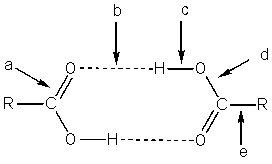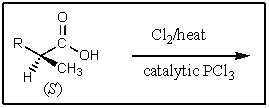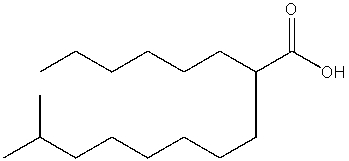A) they are significantly heavier than organic molecules with the same molecular weight.
B) they repel each other in the gas phase.
C) they strongly attract each other in the liquid phase.
D) they are usually solids,and solids are not volatile.
E) they exist mostly as ions (RCO2- + H+) and ionic materials are not volatile.
G) B) and E)
Correct Answer

verified
Correct Answer
verified
Multiple Choice
Which would be the best name of the following compound? 
A) 2-bromo-3-isopropylbutenoic acid
B) (E) -2-bromo-3,4-dimethyl-2-pentenoic acid
C) (E) -2-bromo-3-methyl-2-hexenoic acid
D) (E) -2-bromo-3-methyl-2-pentenoic acid
E) (Z) -2-bromo-3-methyl-2-pentenoic acid
G) A) and C)
Correct Answer

verified
Correct Answer
verified
Multiple Choice
Rank the following in decreasing order of acidity (most acidic on left) : 
A) X > Z > Y
B) Y > X > Z
C) Z > X > Y
D) Z > Y > X
E) X > Y > Z
G) C) and E)
Correct Answer

verified
Correct Answer
verified
Multiple Choice
Which would be the strongest acid of the following?
A) BrCH2CH2CO2H
B) ClCH2CH2CO2H
C) CH3CHClCO2H
D) CF3CO2H
E) CH3CHClCOCl
G) D) and E)
Correct Answer

verified
D
Correct Answer
verified
Multiple Choice
Which of the following intermediates are not involved in the acid catalyzed esterification reaction of a carboxylic acid?
A) ![]()
B) ![]()
C) ![]()
D) ![]()
E) All of the above are intermediates.
G) A) and D)
Correct Answer

verified
Correct Answer
verified
Multiple Choice
In the carboxylic acid dimer (below) ,which bond(s) has a strength of about 6-8 kcal/mol? 
A) Bond a
B) Bond b
C) Bond c
D) Bond d
E) Bond e
G) C) and D)
Correct Answer

verified
Correct Answer
verified
Multiple Choice
Which of the following sets of reagents would accomplish the chemical transformation shown? 
A) ![]()
B) ![]()
C) ![]()
D) ![]()
E) ![]()
G) C) and E)
Correct Answer

verified
Correct Answer
verified
Multiple Choice
What would be the organic product of the following reaction? 
A) CH3CH2CO2H + CO2
B) 2 CH3CO2H
C) ![]()
D) ![]()
E) None of these are formed.
G) A) and E)
Correct Answer

verified
Correct Answer
verified
Multiple Choice
Several 2-arylpropanoic acids are used as analgesics (painkillers) .Three of these [Ibuprofen (= Advil) ,Naproxen (= Aleve) and Ketoprofen (= Orudis KT) ] are currently available in over-the-counter form.Which of the following sets of reagents would accomplish conversion of an ethyl aromatic to a 2-arylpropanoic acid? ![Several 2-arylpropanoic acids are used as analgesics (painkillers) .Three of these [Ibuprofen (= Advil) ,Naproxen (= Aleve) and Ketoprofen (= Orudis KT) ] are currently available in over-the-counter form.Which of the following sets of reagents would accomplish conversion of an ethyl aromatic to a 2-arylpropanoic acid? A) B) C) D) E) both A and B](https://d2lvgg3v3hfg70.cloudfront.net/TB6928/11eab5f7_3d94_4d15_a628_3fd335664c0c_TB6928_00.jpg)
A) ![]()
B) ![]()
C) ![]()
D) ![]()
E) both A and B
G) A) and C)
Correct Answer

verified
Correct Answer
verified
Multiple Choice
Which,if any,of the reactions below would produce 2-methylpropanoic acid?
A) ![]()
B) ![]()
C) ![]()
D) All of these reactions would produce the desired product.
E) None of these reactions would produce the desired product.
G) A) and E)
Correct Answer

verified
Correct Answer
verified
Multiple Choice
What would be the name of the following? 
A) Malonic acid
B) Propanoic acid
C) Oxalic acid
D) Succinic acid
E) Butanedioic acid
G) A) and C)
Correct Answer

verified
Correct Answer
verified
Multiple Choice
Rank the following in order of decreasing acidity (more acidic > less acidic) : 
A) II > III > I > IV > V
B) IV > II > I > III > V
C) II > IV > I > III > V
D) V > III > I > II > IV
E) II > IV > I > V > III
G) A) and D)
Correct Answer

verified
B
Correct Answer
verified
Multiple Choice
Rank the following benzoic acids in order of decreasing acidity: 
A) III > I > II
B) I > III > II
C) II > I > III
D) I > II > III
E) III > II > I
G) C) and E)
Correct Answer

verified
Correct Answer
verified
Multiple Choice
What major product would result from the following reaction? 
A) ![]()
B) ![]()
C) ![]()
D) ![]()
E) ![]()
G) A) and D)
Correct Answer

verified
Correct Answer
verified
Multiple Choice
The higher acidity of carboxylic acids compared to other functional groups is best explained by
A) hydrogen bonding.
B) electronegativity of oxygen.
C) water solubility.
D) resonance.
E) electronegativity of carbon.
G) A) and D)
Correct Answer

verified
Correct Answer
verified
Multiple Choice
Which compound best fits the following spectroscopic data? 1H NMR = 1.00 (t,J=7.4 Hz,3H) ; 1.65 (sextet,J=7.5 Hz,2H) ; 2.31 (t,J=7.4 Hz,2H) ; and 11.68 (s,1H) ppm.13C NMR = 13.4,18.5,36.3,179.6 ppm.
A) ![]()
B) ![]()
C) ![]()
D) ![]()
E) none of the above
G) C) and D)
Correct Answer

verified
Correct Answer
verified
Multiple Choice
What best accounts for the unusually high boiling points of carboxylic acids relative to other organic compounds of similar molecular weight?
A) The relatively large concentration of oxygen atoms.
B) The presence of intramolecular hydrogen bonding.
C) Carboxylic acids are mostly ionized and thus are mostly ionic compounds.
D) The presence of intermolecular hydrogen bonding.
E) Carboxylic acids do not have unusually high boiling points.
G) D) and E)
Correct Answer

verified
Correct Answer
verified
Multiple Choice
What is the IUPAC name of the following compound? 
A) 2-hexyl-9-methyldecanoic acid
B) 2-isononyloctanoic acid
C) 1-methyl-9-carboxypentadecane
D) 2-hexyldecanoic acid
E) 14-methyl-7-carboxypentadecane
G) A) and C)
Correct Answer

verified
Correct Answer
verified
Multiple Choice
Which of the following sets of reagents would convert benzyl bromide to phenylethanoic acid? 
A) ![]()
B) ![]()
C) ![]()
D) ![]()
E) both B and D
G) A) and B)
Correct Answer

verified
E
Correct Answer
verified
Multiple Choice
What reagent(s) would accomplish the following? 
A) Cl2,light
B) Cl2,H2O
C) SOCl2
D) MgCl2
E) aqueous HCl
G) C) and E)
Correct Answer

verified
Correct Answer
verified
Showing 1 - 20 of 27
Related Exams